 |
An Examination of the Retail
Trade Industry in Wyoming
by: Kimber Wichmann
|
Since the July 1997 issue of
Wyoming Labor Force Trends, Research & Planning
has been publishing in-depth studies on Wyoming industries. This
month we focus on Retail Trade. Close to one-quarter of the
workers posted on Wyoming’s wage records
1 depend on Retail Trade as their primary
source of wages. This industry has historically experienced growth
and is expected to continue its growth throughout 1998.
This month’s article will examine three main areas of
Wyoming’s Retail Trade industry. First, a time series reveals
the past performance of Retail Trade in Wyoming. Second, we explore
projections of the industry into 1998. Third, a characterization of
the type of employees that work and stay in the realm of Retail Trade.
Figures will illustrate the seasonal nature of employment in this
industry and reveal what influence spending patterns and sales tax
have on the overall employment of Retail Trade. Tables will show
the age, gender and wages for workers in this industry, as well as
a 39 percent retention rate of Retail Trade workers in Wyoming from
1993 to 1996.
Introduction
Retail Trade consists of the selling of merchandise for personal
and/or home consumption. Selling merchandise is a highly seasonal
industry which is easily influenced by construction projects, weather,
tourism and personal spending patterns. The 1987 Standard Industrial
Classification Manual2 divides the Retail
Trade industry into seven groups. These Standard Industrial
Classification (SIC) groups are:
-
SIC 52 - Building Materials, Hardware, Garden
Supplies, & Mobile Home Dealers
-
SIC 53 - General Merchandise Stores
-
SIC 54 - Food Stores
-
SIC 55 - Auto Dealers & Gas Service Stations
-
SIC 56 - Apparel & Accessory Stores
-
SIC 57 - Home Furniture, Furnishings, & Equipment
Stores
-
SIC 58 - Eating & Drinking Places
-
SIC 59 - Miscellaneous Retail
Figure 1 takes all of the employers, which are called units, under
covered employment (see Glossary) and
distributes them into the seven industry subgroups mentioned above.
Figure 1 also describes the percentage of Retail Trade workers in
each industry. The data used to make the chart was derived from the
Research & Planning ES-202 publication, Wyoming 1996
Annual Covered Employment and Wages3.
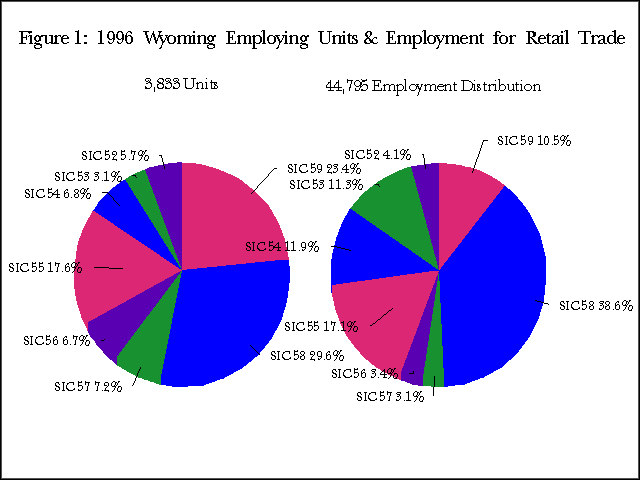
Wage Records and Retail Trade
In total covered employment, with the exception of Federal Government
workers, there were 271,622 workers in 1993. Wage records, in 1993,
indicated that the Retail Trade industry employed 72,690 individuals,
which totaled 27 percent of Wyoming’s wage records. (It is
important to note that wage records counts each individual that
worked at any time during the year, where ES-202 and Current
Employment Statistics (CES) data only count positions worked the
week of the 12th in a given month. Monthly averages are used to
compute annual average employment totals. This is mentioned because
when the charts and tables are compared it is important to know why
the numbers change4.) According to wage
records, 61,040 out of 72,690 Retail Trade workers have Retail Trade
as their primary job. A primary job means that the worker depends on
this employer for the majority of his/her wages. With close to a
quarter of the workers listed on wage records depending on this
industry to earn a living, it is very important to understand what
influences its employment and its performance.
CES and Retail Trade
Figure 2 is a graph of CES data regarding monthly Retail Trade
employment from 1988-96. The employment levels have a seasonal
pattern, which repeats itself in 12-month intervals. The overall
upward trend of the graph reveals employment growth in the industry.
February is the lowest point in the Retail Trade seasonal employment
cycle. In February, there are a variety of factors influencing
Retail Trade. First and foremost is the weather. February is one
of the coldest times of the year in Wyoming. Thus, there are
little to no construction projects planned for this time of the
year and therefore there aren’t purchases being made for
construction activities, which fuels the Retail Trade SIC 52 -
building materials. Therefore, if construction is down, and
purchasing is down, the business for SIC 52 is waning which means
the Retail Trade employment subsides during the cold weather
until construction picks up again. Also, with cooler weather,
tourism is at a low for the year. Tourism fuels many elements
within the Retail Trade industry such as gas stations, eating &
drinking places, food stores, general merchandise stores, and
apparel & accessory stores just to name a few.
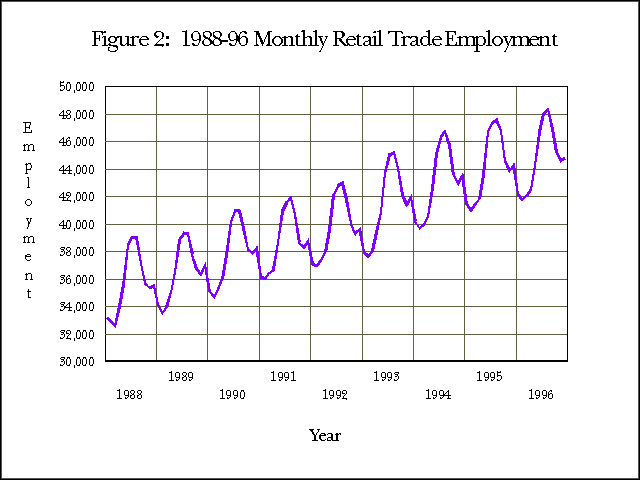
Another factor which contributes to the lull in employment is that
all of the “seasonal” help hired on a temporary basis for
the holidays have been released. March signals steady employment
growth which continues for five months peaking in August. The
growth is due to better weather, which stimulates construction and
tourism, which, as mentioned above, are major influences on Retail
Trade industries. As the summer months pass and fall begins,
employment declines.
Some factors which could explain the decline are that many of the
employees that work in Retail Trade are of high school and college
age and fall is when school begins. Thus, many workers that were
once available to work are spending their time in school. Another
factor that could explain the decline in the fall season is that
construction wanes, and the surge of tourism passes as the weather
continues to get colder. The decline continues through November.
As the holidays begin and Christmas nears, temporary employees are
hired and the Retail Trade industry employment sees a brief seasonal
surge in December. The increase is attributable to employers seeking
additional workers for temporary employment throughout the holiday
season. The increase quickly declines through January and bottoms
out in February when the seasonal cycle repeats itself.
Growth Rates
Even though the employment pattern repeats itself and the employment
level overall is increasing over the years, the annual growth varies
from year to year as shown in Figure 3. It is interesting that the
employment in the Retail Trade industry reached its height of growth
in 1994 along with the peaking of Wyoming’s statewide growth.
Both growth rates maintained the same general trend over time.
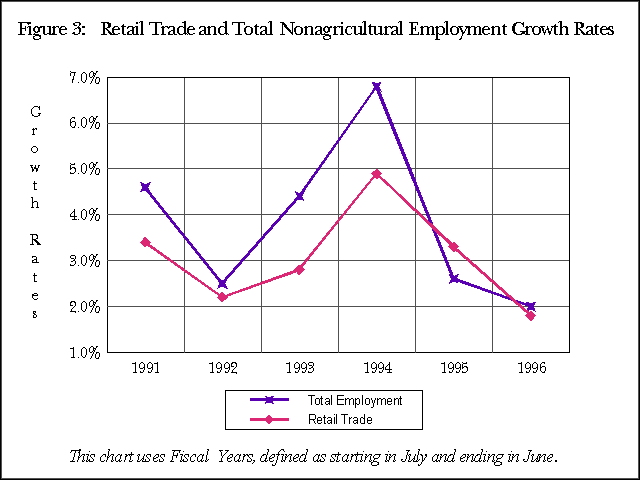 Revenue generated by retail sales tax is also an indicator of the
employment performance in the Retail Trade industry. Figure 4
illustrates the similarity in trends between Retail Trade employment
and sales tax. Both reveal gradual growth throughout the years.
Also, the retail sales tax shows a big increase in 1994 which
coincides with the statewide and Retail Trade growth rates for
1994 mentioned above.
Revenue generated by retail sales tax is also an indicator of the
employment performance in the Retail Trade industry. Figure 4
illustrates the similarity in trends between Retail Trade employment
and sales tax. Both reveal gradual growth throughout the years.
Also, the retail sales tax shows a big increase in 1994 which
coincides with the statewide and Retail Trade growth rates for
1994 mentioned above.
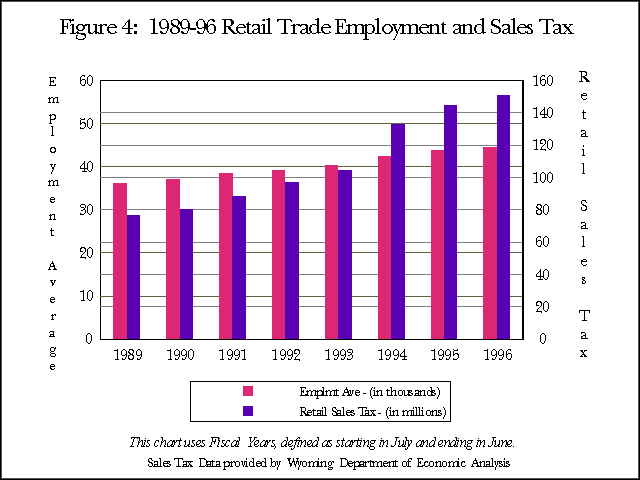
1998 Projections
Using the three-month average and a base year of 1996 CES data, with
various regression models, Employment Projections were made for the
Retail Trade industry in 1998. All of the indicators--employment
history, growth rates and sales tax--contribute to the overall
behavior of the industry. Figure 5 illustrates Retail Trade's
continued growth and seasonal patterns. The growth in 1997 slowed
and showed a minimal increase. Figure 5 suggests that 1998 could
have a slight increase with a bit more growth than the year before.
Overall, the graph illustrates continued growth but at a much slower
rate than we had seen in Figure 2.
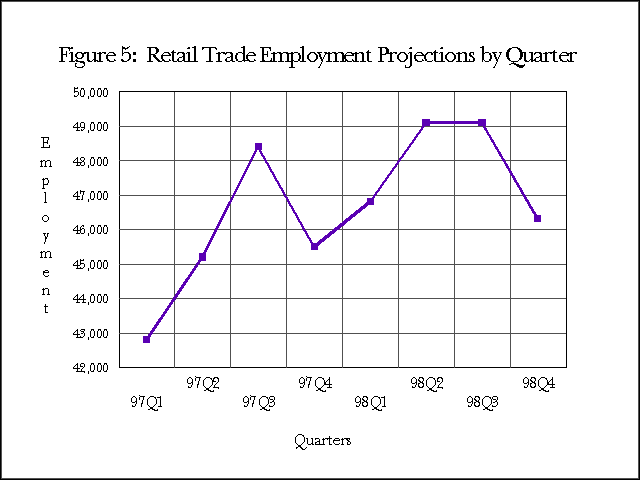
Workers Who Depend on Retail Trade
Now that the history and probable future growth for Retail Trade
has been established, the focus turns to the individuals who depend
on the industry as their main source of employment and wages: the
workers. According to wage records in 1993, there were 72,690
people in Wyoming employed by the Retail Trade industry. That
totaled 27 percent of the jobs in Wyoming. Although 84 percent
of the workers in this industry depend on Retail Trade as their
primary job, 67 percent of these workers depend exclusively on
one Retail Trade employer as their source of income. Only 33
percent of the workers who held Retail Trade as their primary
job were working Retail Trade and another job at some point in
1993.
Gender Distributions
Most of the workers in Retail Trade (57%) are female. Males
dominate most industries in Wyoming. The fact that this is not
the case in Retail Trade makes the industry unique in Wyoming.
The percentage of females to males (43%) is a fairly even gender
distribution for Wyoming industry, which would seem to make
Retail Trade ideal for gender comparisons of wages and retention
of workers within the industry. However, this study of employment
in the Retail Trade industry is just that, a study of employment
not of occupation or of tenure. Therefore, when looking at wages
and gender one must be careful not to draw direct comparisons.
Age Distributions
Table 1 shows those individuals who had Retail Trade as their
primary job in 1993. The Table was made by taking wage records
for all four quarters in 1993 and matching Social Security Numbers
with the current Wyoming Driver’s License file. This allows
information such as gender and age to be determined. The record
files that could not be matched by Social Security Numbers for
various reasons. The Table breaks out wages earned over the year,
by gender and age. The largest number of males (4,557 workers)
are 25-34 years old. Males have the largest wage concentration
in the highest wage section ($12,452.50+ per year). Females also
have the most workers on the 25-34 year old category. The largest
wage concentration for females falls in the $6,350.89-$12,452.49
per year wage section.
Table 1: 1993
Retail Trade Primary Job by Gender, Age and Wage
| | |
|
ANNUAL WAGE |
| GENDER
|
AGE
|
$0-1,170.58
|
$1,170.59-3,035.32
|
$3,035.33-6,350.88
|
$6,350.89-12,452.49
|
$12,452.50+
|
TOTAL
|
TOTAL %
|
|
| Male
|
0-15
|
262 |
110 |
14 |
1 |
0 |
387
|
2.0% |
|
16-19 |
1,397 |
1,471 |
1,104 |
374 |
29 |
4,375
|
22.4% |
|
20-24 |
560 |
668 |
929 |
1,100 |
624 |
3,881
|
19.9% |
|
25-34 |
424 |
376 |
640 |
964 |
2,153 |
4,557
|
23.3% |
|
35-44 |
210 |
208 |
292 |
539 |
1,869 |
3,118
|
16.0% |
|
45-54 |
123 |
123 |
137 |
284 |
1,120 |
1,787
|
9.2% |
|
55-64 |
67 |
84 |
92 |
170 |
505 |
918
|
4.7% |
|
65+ |
86 |
90 |
109 |
136 |
77 |
498
|
2.6% |
|
Total |
3,129
|
3,130
|
3,317
|
3,568
|
6,377
|
19,521
|
100.0% |
|
Total % |
16.0% |
16.0% |
17.0% |
18.3% |
32.7% |
100.0% |
|
| Female
|
0-15
|
250 |
90 |
10 |
1 |
0 |
351
|
1.4% |
|
16-19 |
1,503 |
1,703 |
1,228 |
307 |
8 |
4,749
|
18.4% |
|
20-24 |
855 |
1,072 |
1,196 |
1,075 |
229 |
4,427
|
17.2% |
|
25-34 |
963 |
991 |
1,210 |
1,581 |
1,217 |
5,962
|
23.1% |
|
35-44 |
595 |
651 |
988 |
1,501 |
1,418 |
5,153
|
20.0% |
|
45-54 |
351 |
351 |
533 |
949 |
851 |
3,035
|
11.8% |
|
55-64 |
203 |
169 |
298 |
504 |
352 |
1,526
|
5.9% |
|
65+ |
120 |
110 |
134 |
151 |
39 |
554
|
2.2% |
|
Total |
4,840
|
5,137
|
5,597
|
6,069
|
4,114
|
25,757
|
100.0% |
|
Total % |
18.8% |
19.9% |
21.7% |
23.6% |
16.0% |
100.0% |
|
| Both
|
0-15
|
512 |
200 |
24 |
2 |
0 |
738
|
1.6% |
|
16-19 |
2,900 |
3,174 |
2,332 |
681 |
37 |
9,124
|
20.2% |
|
20-24 |
1,415 |
1,740 |
2,125 |
2,175 |
853 |
8,308
|
18.3% |
|
25-34 |
1,387 |
1,367 |
1,850 |
2,545 |
3,370 |
10,519
|
23.2% |
|
35-44 |
805 |
859 |
1,280 |
2,040 |
3,287 |
8,271
|
18.3% |
|
45-54 |
474 |
474 |
670 |
1,233 |
1,971 |
4,822
|
10.6% |
|
55-64 |
270 |
253 |
390 |
674 |
857 |
2,444
|
5.4% |
|
65+ |
206 |
200 |
243 |
287 |
116 |
1,052
|
2.3% |
|
Total |
7,969
|
8,267
|
8,914
|
9,637
|
10,491
|
45,278
|
100.0% |
|
Total % |
17.6% |
18.3% |
19.7% |
21.3% |
23.2% |
100.0% |
|
|
Missing* |
5,577
|
4,163
|
2,910
|
1,878
|
1,234
|
15,762
|
25.8% |
|
Total % |
9.1% |
6.8% |
4.8% |
3.1% |
2.0% |
25.8% |
|
|
Overall Total |
13,546
|
12,430
|
11,824
|
11,515
|
11,725
|
61,040
|
|
Overall Total % |
22.2% |
20.4% |
19.4% |
18.9% |
19.2% |
100.0% |
*Missing files are those wage records that
could not be matched by Social Security Numbers to the Wyoming
Driver's License files, therefore gender and age could not be
determined.
The age group of 25-34 year olds make up the largest section of
workers in Retail Trade (17.2%). One reason for this could be
that these people are within the ages of non-traditional college
students and could be trying to attain some sort of advanced
education and the seasonal schedule and flexible hours of Retail
Trade make it manageable for them to work and go to school. This
industry may attract people with children because of the flexible
schedule and hours of the industry. Therefore, they could work
while their kids attend school. Another type of worker that
would fall in this age group are those who are trying to get
experience for their resumes. This industry could be a first
job for many individuals, and since many Retail Trade jobs
don’t require work experience it is a relatively easy
industry to get into. Other workers in this age group may be
married and could be working in Retail Trade to supplement a
spouse’s income or just for something to do during the day.
Teenagers make up 16.2 percent of the primary jobs in Retail Trade.
These workers are of high school age and could be going to school
and working part time. They are not usually trying to earn an
income to support themselves or an entire family. Retail Trade
jobs are, for the most part, "low paying" jobs that
don’t require previous experience or special skills.
Naturally, a teenager with no prior work experience and who
only wishes to work for a little extra spending money is an
ideal employee for the Retail Trade industry. For a more
in-depth analysis of teenagers in the work force please read
the article “Work Experiences
of Wyoming’s Youth” in the July 1997 issue of
Trends
5.
A Comparison of 1993 to 1996
The year 1996 didn’t bring a lot of change regarding the
characteristics of workers in Retail Trade. Table 2 reveals
the same layout as Table 1 only for 1996.
Table 2 was made the same way as Table 1 by matching wage
records with the Wyoming Driver’s License database.
The results revealed that there were 77,110 workers who worked
in Retail Trade in 1996 and 83 percent (64,355) of them had it
as their primary job. The gender distribution for 1996 is 42
percent male and 58 percent female for all Retail Trade jobs,
which is a one percent change from 1993. The largest number
of males (4,497 workers) are still 25-34 years old. The
biggest concentration of wages for males remains in the highest
wage section ($13,519.60+ per year). Females have the most
workers (5,442) in the 24-35 year old age category as well.
The largest concentration of wages for females remains in
the second highest wage category ($6,817.05-$13,519.59).
Table 2: 1996 Retail Trade Primary Job by
Gender, Age and Wage
| | | |
ANNUAL WAGE |
| GENDER
|
AGE |
$0-1,199.09
|
$1,199.10-3,230.78
|
$3,230.79-6,817.04
|
$6,817.05-13,519.59
|
$13,519.60+
|
TOTAL |
TOTAL %
|
|
| Male
|
0-15 |
71 |
34 |
2 |
2 |
0 |
109 |
0.6% |
| 16-19
|
997 |
1,098 |
847 |
321 |
24 |
3,287 |
18.0% |
| 20-24
|
598 |
656 |
856 |
909 |
536 |
3,555 |
19.5% |
| 25-34
|
445 |
442 |
637 |
1,084 |
1,889 |
4,497 |
24.7% |
| 35-44
|
228 |
230 |
277 |
534 |
1,903 |
3,172 |
17.4% |
| 45-54
|
130 |
126 |
175 |
368 |
1,233 |
2,032 |
11.2% |
| 55-64
|
89 |
92 |
99 |
199 |
521 |
1,000 |
5.5% |
| 65+
|
126 |
109 |
122 |
127 |
84 |
568 |
3.1% |
| Total
|
2,684 |
2,787 |
3,015 |
3,544 |
6,190 |
18,220 |
100.0% |
| Total %
|
14.7% |
15.3% |
16.5% |
19.5% |
34.0% |
100.0% |
|
| Female
|
0-15 |
105 |
38 |
1 |
0 |
0 |
144 |
0.6% |
| 16-19
|
1,160 |
1,452 |
1,034 |
276 |
10 |
3,932 |
15.7% |
| 20-24
|
812 |
1,105 |
1,306 |
1,144 |
184 |
4,551 |
18.2% |
| 25-34
|
912 |
900 |
1,162 |
1,426 |
1,042 |
5,442 |
21.7% |
| 35-44
|
622 |
644 |
1,029 |
1,555 |
1,553 |
5,403 |
21.6% |
| 45-54
|
360 |
364 |
594 |
1,075 |
918 |
3,311 |
13.2% |
| 55-64
|
193 |
195 |
314 |
584 |
375 |
1,661 |
6.6% |
| 65+
|
129 |
112 |
164 |
170 |
41 |
616 |
2.5% |
| Total
|
4,293 |
4,810 |
5,604 |
6,230 |
4,123 |
25,060 |
100.0% |
| Total %
|
17.1% |
19.2% |
22.4% |
24.9% |
16.5% |
100.0% |
|
| Both
|
0-15 |
176 |
72 |
3 |
2 |
0 |
253 |
0.6% |
| 16-19
|
2,157 |
2,550 |
1,881 |
597 |
34 |
7,219 |
16.7% |
| 20-24
|
1,410 |
1,761 |
2,162 |
2,053 |
720 |
8,106 |
18.7% |
| 25-34
|
1,357 |
1,342 |
1,799 |
2,510 |
2,931 |
9,939 |
23.0% |
| 35-44
|
850 |
874 |
1,306 |
2,089 |
3,456 |
8,575 |
19.8% |
| 45-54
|
490 |
490 |
769 |
1,443 |
2,151 |
5,343 |
12.3% |
| 55-64
|
282 |
287 |
413 |
783 |
896 |
2,661 |
6.1% |
| 65+
|
255 |
221 |
286 |
297 |
125 |
1,184 |
2.7% |
| Total
|
6,977 |
7,597 |
8,619 |
9,774 |
10,313 |
43,280 |
100.0% |
| Total %
|
16.1% |
17.6% |
19.9% |
22.6% |
23.8% |
100.0% |
|
|
Missing* |
7,449 |
5,566 |
3,729 |
2,393 |
1,938 |
21,075 |
32.7% |
|
Total % |
11.6% |
8.6% |
5.8% |
3.7% |
3.0% |
32.7% |
|
| Overall
Total |
14,426 |
13,163 |
12,348 |
12,167 |
12,251 |
64,355
|
|
Overall Total % |
22.4% |
20.5% |
19.2% |
18.9% |
19.0% |
100.0% |
*Missing files are those wage record files
that could not be matched by Social Security Numbers to the
Wyoming Driver's License files, therefore gender and age could
not be determined.
Employment Turnover
Due to the fact that teenagers make up a significant part of
the Retail Trade employment, it might be expected that the
industry would have a higher turnover rate as those teenagers
age. Spending their teenage years in Retail Trade may have
given them the work experience needed to advance in a new
career which pays more as their need for more income increases.
Also, employing teenagers can be a seasonal challenge as many
teenagers are of high school and college age, which means they
must attend classes. Some may be able to juggle both classes
and a job in Retail Trade while others may work on the holidays
and summer breaks from school but prefer to attend classes full
time during the traditional school year.
A database was created to see what the actual turnover was in
the industry. Wage records from 1993 were matched with wage
records from 1996. This supplied all workers in 1993 who
remained working in Wyoming in 1996. To get only those workers
who stayed in Retail Trade a match was done on Social Security
Numbers and SIC codes 52-59 (the seven groups of the Retail
Trade industry mentioned at the beginning of this article).
The results showed that 23,611 workers out of the original
61,040 stayed with Retail Trade as their primary job. Over
half (61%) of all employees in Retail Trade either leave the
labor force or find another job in a different industry. That
means the industry had a 39 percent retention rate of its
employees from 1993-1996. Table 3 shows the age breakouts and
gender of the workers who remained in the industry. Ages are
separated by how old the workers were in 1993.
Table 3: Retail Trade Workers that Remained
in the Industry from 1993 to 1996 by Gender and Age
| | | |
GENDER |
| Age |
Male |
% Males |
Female |
% Females |
Unknown |
Total |
% Total |
| 0-15
|
180 |
2.1% |
216 |
1.8% |
| 396 |
1.7% |
| 16-19
|
1,368 |
16.3% |
1,962 |
16.5% |
| 3,330 |
14.1%
|
| 20-24
|
1,269 |
15.1% |
1,515 |
12.7% |
| 2,784 |
11.8% |
| 25-34
|
2,068 |
24.6% |
2,668 |
22.4% |
| 4,736 |
20.1% |
| 35-44
|
1,710 |
20.3% |
2,723 |
22.9% |
| 4,433 |
18.8% |
| 45-54
|
1,054 |
12.5% |
1,701 |
14.3% |
| 2,755 |
11.7%
|
| 55-64
|
522 |
6.2% |
837 |
7.0% |
| 1,359 |
5.8% |
| 65+
|
238 |
2.8% |
269 |
2.3% |
| 507 |
2.1% |
| Missing*
| | | | |
3,311
|
3,311 |
14.0%
|
| Total
|
8,409 |
100.0% |
11,891 |
100.0% |
3,311 |
23,611 |
100.0% |
*Missing files are those wage records that
could not be matched by Social Security Numbers to the Wyoming
Driver's License files, therefore gender and age could not be
determined.
The retention rate of 39 percent could be due to a variety of
elements. A few factors could be the low wages and the
inconsistent hours. These factors discourage many workers
from making a career out of Retail Trade. So, as this study
shows, the majority of workers look to Retail Trade as a
temporary job that gives them some work experience and a
little pocket money and once they see an opportunity to
move on, the majority of workers do.
Conclusion
This article has taken a brief yet in-depth look at the past
performance, future outlook, and other factors which influence
the Retail Trade industry. The seasonal nature of Retail Trade
employment was explored, and found that construction projects,
tourism, and the weather greatly influence the employment pattern
of the time series. CES data combined with various regression
models optimistically forecast future growth for Retail Trade.
Workers in this industry total nearly 25 percent of the total
Wyoming workers on wage records. The distribution between genders
remained fairly even from 1993 to 1996 with only a one percent
change. Teenagers and individuals between 25 and 34 years old
make up the highest concentration of workers in the industry.
Lack of work experience and flexible hours are possible
explanations for this. When comparing how many workers
stayed in Retail Trade from 1993 until 1996, over half
of the workers (61%) left the Wyoming labor force or found
another job in a different industry. Low wages and the lack
of benefits are possible explanations for the 39 percent
retention of workers. Overall, the Retail Trade industry is
growing and is anticipated to continue its growth throughout
1998. Employee retention numbers do not seem to influence the
seasonal pattern or hurt the yearly growth.
1 Wage records - All
employees and earnings of those individuals whose employer is
subject to Wyoming’s Unemployment Insurance laws. This
excludes federal and self-employed individuals.
2 Executive Office of
the President: Office of Management and Budget, Standard
Industrial Classification Manual, 1987, pp. 313-334.
3 Wyoming Department
of Employment, Research & Planning, Wyoming 1996 Annual Covered
Employment & Wages, 1996.
4 Mike Evans, “
Understanding the Different
Employment Measures,” Trends, April 1998.
5Carol Toups, “Work Experiences of Wyoming’s
Youth,” Trends, July 1997.
Kimber Wichmann is a Senior Statistician with Research &
Planning, specializing in Current Employment Statistics (CES).
This article was published in the
Wyoming Labor Force Trends May
1998 issue.
|
|